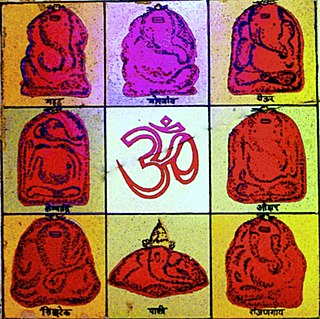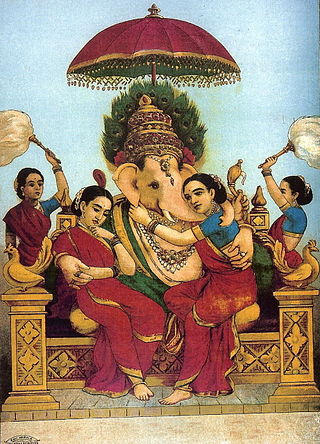
Ashtavinayaka is a Sanskrit term which means "eight Ganeshas". The Ashtavinayaka Yatra refers to a pilgrimage to the eight Hindu temples in the state of Maharashtra, India, centered around the city of Pune. The eight temples house eight distinct idols of Ganesha, the Hindu deity of unity, prosperity, learning, and removing obstacles. Each of these temples has its own individual legend and history, as distinct from each other as the murtis in each temple. The form of each murti of Ganesha and his trunk are distinct from one another. There are other temples of eight Ganesha in various other parts of Maharashtra; however, the ones around Pune are more well known and visited. To complete the Ashtavinayaka Yatra, one must revisit the first temple after visiting all the eight temples.

Narayangaon is a town in the Junnar taluka of the Pune district of Maharashtra state, India. Water is abundant because of its proximity to the major dams, the western ghats, and the Sahyadri mountain range.

Ganesh Chaturthi, also known as Vinayak Chaturthi or Ganeshotsav, is a Hindu festival that tributes Hindu deity Ganesha. The festival is marked with the installation of Ganesha's clay murtis privately in homes and publicly on elaborate pandals. Observances include chanting of Vedic hymns and Hindu texts, such as prayers and vrata (fasting). Offerings and prasada from the daily prayers, that are distributed from the pandal to the community, include sweets such as modak as it is believed to be a favourite of Lord Ganesha. The festival ends on the tenth day after start, when the Murti is carried in a public procession with music and group chanting, then immersed in a nearby body of water such as a river or sea, called visarjana on the day of Ananta Chaturdashi. In Mumbai alone, around 150,000 Murtis are immersed annually. Thereafter the clay Murti dissolves and Ganesha is believed to return to his celestial abode.

BallaleshwarPali is one of the eight temples of the Hindu God Ganesha. Among Ganesha temples, Ballaleshwar is the only one dedicated to Ganesha that is known by his devotee's name. It is located in the village of Pali which is 28 km from Roha in the Raigad district of Maharashtra, India. It is situated between fort Sarasgad and the river Amba.

Lenyadri, sometimes called Ganesa Lena, Ganesh Pahar Caves, are a series of about 30 rock-cut Buddhist caves, located about 4.8 kilometres (3.0 mi) north of Junnar in Pune district in the Indian state of Maharashtra. Other caves surrounding the city of Junnar are: Manmodi Caves, Shivneri Caves and Tulja Caves. The Lenyadri caves date between the 1st and 3rd century AD and belong to the Hinayana Buddhism tradition.

Varadvinayak, also spelt as Varadavinayaka, is one of the Ashtavinayak temples of the Hindu deity Ganesha. It is located in Mhad village situated in Khalapur taluka near Karjat and Khopoli of Raigad District, Maharashtra, India. The temple was built (restored) by Peshwa General Ramji Mahadev Biwalkar in 1725AD.

The Ganesha Purana is a Sanskrit text that deals with the Hindu deity Ganesha. It is an upapurāṇa that includes mythology, cosmogony, genealogy, metaphors, yoga, theology and philosophy relating to Ganesha.
The Mudgala Purana is a Hindu religious text dedicated to the Hindu deity Ganesha. It is an upapurāṇa that includes many stories and ritualistic elements relating to Ganesha. The Ganesha Purana and the Mudgala Purana are core scriptures for devotees of Ganesha, known as Ganapatyas. These are the only two Purana that are exclusively dedicated to Ganesha.

India and Hinduism has influenced many countries in other parts South Asia, East Asia and Southeast Asia as a result of commercial and cultural contacts. Ganesha is one of many Hindu deities who reached foreign lands as a result.

There are many anecdotes of Ganesha. Ganesha's elephant head makes him easy to identify. He is worshipped as the lord of beginnings and as the lord of removing obstacles, the patron of arts and sciences, and the god of intellect and wisdom. In his survey of Ganesha's rise to prominence in Sanskrit literature, Ludo Rocher notes that:
Above all, one cannot help being struck by the fact that the numerous stories surrounding Gaṇeśa concentrate on an unexpectedly limited number of incidents. These incidents are mainly three: his birth and parenthood, his elephant head, and his single tusk. Other incidents are touched on in the texts, but to a far lesser extent.

The marital status of Ganesha varies widely in mythological stories and the issue has been the subject of considerable scholarly review. Several patterns of associations with different consorts are identifiable. One pattern of myths identifies Ganesha as an unmarried brahmacārin with no consorts. Another mainstream pattern associates him with the concepts of Buddhi (intellect), Siddhi, and Riddhi (prosperity); these qualities are sometimes personified as goddesses who are considered to be Ganesha's wives. Another pattern connects Ganesha with the goddess of culture and the arts, Sarasvati. In the Bengal region he is linked with the banana tree, Kala Bo. Usually Ganesha's consort is portrayed as his shakti, a personification of his creative energy.

Ganesha, also spelled Ganesh, and also known as Ganapati, Vinayaka, and Pillaiyar, is one of the best-known and most worshipped deities in the Hindu pantheon and is the Supreme God in the Ganapatya sect. His depictions are found throughout India. Hindu denominations worship him regardless of affiliations. Devotion to Ganesha is widely diffused and extends to Jains and Buddhists and beyond India.

Ganesh Jayanti (literally "Ganesha's birthday", also known as Magha shukla chaturthi, Tilkund chaturthi, and Varad chaturthi, is a Hindu festival. This occasion celebrates the birth day of Ganesha, the lord of wisdom. It is a popular festival particularly in the Indian state of Maharashtra and it is also celebrated in Goa held during the shukla paksha chaturthi day in the month of Magha as per the Hindu calendar, which corresponds to the Gregorian calendar month of January/February. In 2022, Ganesh Jayanti falls on 4 February.

Shri Mayureshwar Mandir or Shri Moreshwar Temple is a Hindu temple (mandir) dedicated to Ganesha, god of wisdom. It is located in Moragaon in Pune District, about 65 km away from Pune city in the Indian state of Maharashtra. The temple is the starting and ending point of a pilgrimage of eight revered Ganesha temples called Ashtavinayaka.

The Chintamani Temple of Theur is a Hindu temple dedicated to Supreme God Ganesha according to Ganapatya Sect located 25 km (16 mi) from Pune, the temple is "one of the larger and more famous" of the Ashtavinayaka, the eight revered shrines of Ganesha in the Indian state of Maharashtra.

The Siddhivinayak Temple of Siddhatek is a Hindu temple dedicated to Ganesha, the elephant-headed god of wisdom. The temple is one of the Ashtavinayaka, the eight revered shrines of Ganesha in the Indian state of Maharashtra and the only Ashtavinayaka shrine in Ahmednagar district.

Vinayaki (Vināyakī) is an elephant-headed Hindu goddess. Her mythology and iconography are not clearly defined. Little is told about her in Hindu scriptures and very few images of this deity exist.

"Vatapi Ganapatim", also known as "Vatapi ganapatim bhajeham" or "Vatapi ganapatim bhaje", is a Sanskrit kriti song by the South Indian poet-composer Muthuswami Dikshitar (1775–1835), one of the "Trinity of Carnatic music". The panegyrical hymn praises Vatapi Ganapati, Ganesha (Ganapati) worshipped in a shrine in Tiruchenkattankudi Utrapatishwaraswamy Temple dedicated to lord Shiva in Thiruvarur district in the Tamil Nadu state of India. The hymn is composed in Hamsadhvani raga ; however, in tradition of kritis, individual performers add their own variations in the tune as a part of improvisation. Vatapi Ganapatim is considered the best-known piece of Muthuswami Dikshitar and is one of the most popular compositions of Carnatic music. The hymn is traditionally sung at the beginning of many Carnatic music concerts.




















